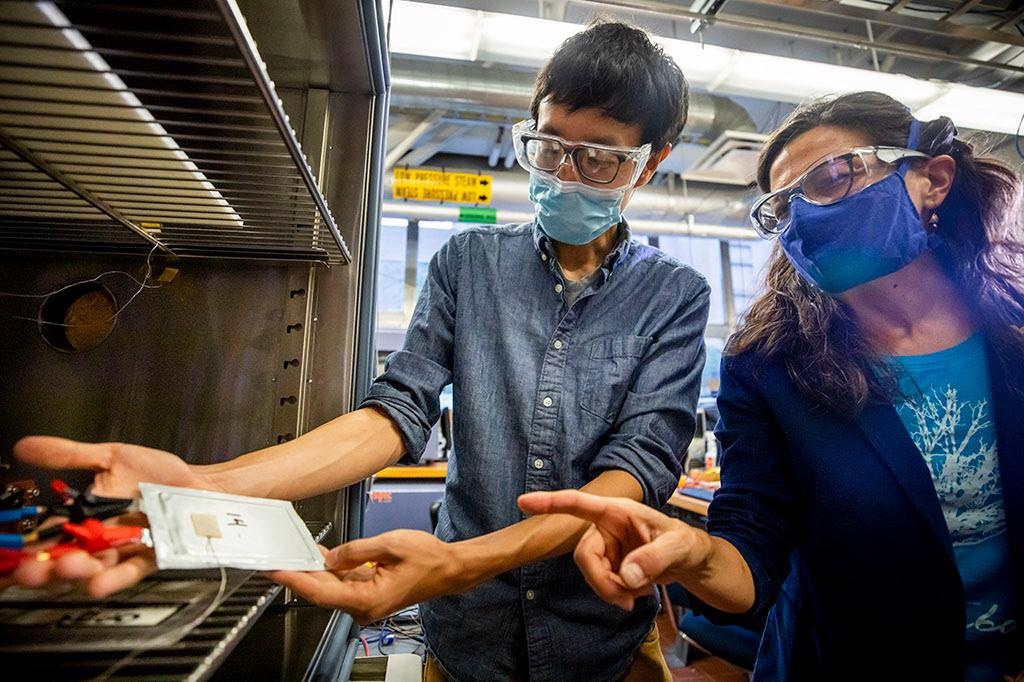At the University of Michigan (U-M), researchers have come up with a new method to meet the increasing demand for electric vehicle batteries. This technique helps predict how variations to manufacturing processes and materials will influence the life of a battery.
 Andrew Weng, a PhD student in mechanical engineering, and Anna Stefanopoulou, the William Clay Ford Professor of Technology, identify an early-life diagnostic signal that predicts the impact of the formation protocols on battery life without needing cycle life testing. Image Credit: Robert Coelius/Michigan Engineering Communications & Marketing.
Andrew Weng, a PhD student in mechanical engineering, and Anna Stefanopoulou, the William Clay Ford Professor of Technology, identify an early-life diagnostic signal that predicts the impact of the formation protocols on battery life without needing cycle life testing. Image Credit: Robert Coelius/Michigan Engineering Communications & Marketing.
U-M engineers have determined that internal resistance, quantified immediately after cells are made, is the main indicator of how long a battery will last. The measurements can be performed within seconds at the rear end of the manufacturing process at very little to no extra charges.
Earlier studies have shown that lifespan prediction is feasible. However, it needs repeated cycling—charging, discharging, and recharging—to collect data required to train the algorithm. Aging tests required to identify lifespan can take nearly weeks to months to be completed. Therefore, the tests are executed on only a few cells and not all the cells produced.
However, the new study, recently reported in the journal Joule, demonstrates that precise battery lifetimes can be predicted through a single resistance measurement or a measure of how much the battery battles the flow of current within it.
That resistance could be obtained from the materials utilized for internal components, or electrochemical factors that impact how well ions tend to shift between the battery electrodes. It is crucial to quantify the resistance at low levels of charge.
The resistance measurement, at low state of charge, can, in principle, be obtained without any cycling, making the model training process much faster.
Andrew Weng, Study Lead Author and Doctoral Student in Mechanical Engineering, University of Michigan
Why is Resistance Such a Good Barometer for Battery Life Estimates?
Resistance can indicate how much lithium is combined with the liquid electrolyte that ferries ions from one electrode to the other within the battery. That combination layer, called the solid electrolyte interphase, can safeguard the surface of the electrode and allow longer lifetimes.
Generally, the amount of lithium added to the solid electrolyte interphase is hard to quantify. However, at a low state of charge, the internal resistance of the battery is associated with how much lithium was added to the solid electrolyte interphase. This offers a quick measure of that protective layer, as well as the battery’s operating capacity, along with normal equipment.
The study performed at U-M offers a valuable tool for automakers at a time when a majority of them are rapidly moving their product lines away from internal combustion technology to embrace electric and hybrid transportation. The shift makes the industry compete for lithium-ion battery materials. This seeks to increase productivity and decrease costs simultaneously.
As Reuters reported in early October 2021, those factors have led to a “bottleneck for EV batteries.”
Carmakers are always trying to decrease the cost of producing cars, and right now, they’re looking to make EV batteries as cost-effective as possible. So the question we’ve tried to answer is ‘How fast can you learn about battery lifetime during the manufacturing process itself?
Anna Stefanopoulou, William Clay Ford Professor of Technology and Leader of the research team, University of Michigan
Stefanopoulou added, “It turns out that the answer is, ‘Immediately, if you know the critical signal that can be acquired in a high-throughput testing.’ Finding such key measurable features can be simply used for continuous improvements and scaling up domestic battery manufacturing.”
The study was financially supported by the National Science Foundation. The team performed experiments in the U-M Battery Laboratory. A collaborator at Stanford University assisted with the analysis.
Journal Reference:
Weng, A., et al. (2021) Predicting the impact of formation protocols on battery lifetime immediately after manufacturing. Joule. doi.org/10.1016/j.joule.2021.09.015.